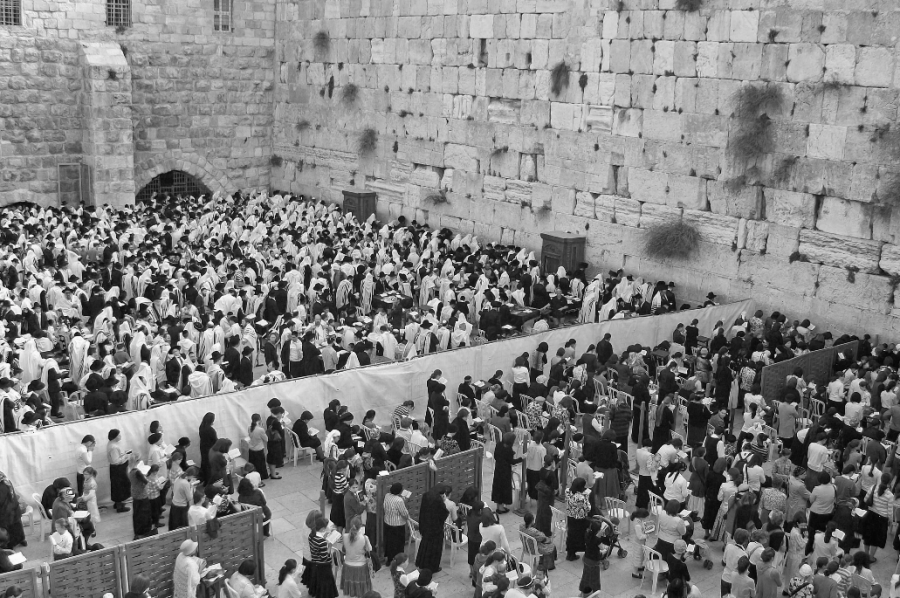Women’s Rights at the Western Wall
Holiday Issue
December 19, 2016
The Temple Mount in Jerusalem, Israel, is regarded as the holiest place in Judaism, as it is believed that God’s divine presence is more prominent there than in any other location in the world. The first temple was built, according to scripture, in 957 BCE, and destroyed 371 years later by the Babylonians. The second temple was built, according to archeological evidence, in 349 BCE, and then destroyed by the Romans 420 years later in 70 C.E. Between 70 C.E. and 2016, the Jewish people’s ability to pray at the Western Wall (Kotel), the last remaining outer wall of the second Holy Temple, has not been easy as a result of different countries, cultures, and religions restricting Jewish presence there. However, ever since the Jews recaptured the area of East Jerusalem, which included the Western Wall, from the Jordanians in the 1967 War, the Jewish people have had full access and ability to pray at the Western Wall.
According to Jewish tradition, men and women have different roles; both gender’s roles and responsibilities are viewed as equally valuable and important, each being unique to the specific gender. However, with the rise of the Conservative and Reform movements beginning in the 1800s, these roles have blended and have become less significant to many modern day Jews. In 2016, many common practices among the Jewish people with regards to men and women that have taken place for thousands of years have changed. The majority of these changes have occurred without causing too much conflict, as they have not directly affected Orthodox Jews who wish to continue carrying out traditional practices within their own synagogues and their own lives. One of these traditional practices is that of men and women praying separately, both in services and at the Western Wall. It is said that this tradition is in place not only to avoid distraction in prayer services, but also because men and women are very different beings, therefore they can connect more with God and themselves when physically separated from each other. Another of these traditions is that women cannot lead prayer services or read directly from the Torah. These traditions sit uncomfortably with many women today, who strongly believe that they have a right to perform these rituals just as men have done throughout history.
These core differences in beliefs between Orthodox Jews and non-Orthodox Jews have caused conflict at the Western Wall in Jerusalem. Progressive women’s groups, the most prominent one being “Women of the Wall,” have dedicated their lives to fighting for equal prayer rights at the Wall. Until January 31st, 2016 at the Western Wall, women had not been allowed to wrap themselves in prayer shawls, read from a Torah scroll, read aloud, or pray alongside men. On January 31st, these restrictions were abolished, and a portion of the wall was dedicated where women could perform these rituals and pray with men. So, all solved then, right? Not quite. The Israeli government has yet to take action to implement any legislation with regards to this decision, and people are beginning to get impatient. At the beginning of November, a liberal group of American women rabbis protested at the Western Wall holding up fourteen Torah scrolls, demanding that they receive the rights that they thought had already been established back in January. After the protest, Prime Minister Benjamin Netanyahu accused these women of causing “unnecessary friction” and of “the unilateral violation of the status quo at the Western Wall,” according to the New York Times. The protestors claimed that they had engaged in “an act of spiritual disobedience.”
Wilmington Friends Students had varying opinions when asked whether or not they thought that women should gain the rights that they are fighting for at the Western Wall. Owen Ganse ’17 explained: “If you change the rules at the Western Wall, then you will have to change a lot of other stuff as well. There are other things that separate men and woman in a lot of religions, so if you change that then you are opening up negotiations to change everything. It would not be a bad idea, but people surely would not like it.” Ganse is not the first person to present concerns about this new rule being a ‘door opener’ for other drastic changes. The idea of even more gender ‘barriers’ being broken down is disconcerting for more traditional Jews, while non-orthodox Jews welcome this notion with open arms. Myla Brilliant ’17 commented on finding a good balance that pleases everyone: “It’s tough because there has to be a balance between understanding sacred tradition and adapting it to fit more modern ideals. Tradition is really deeply rooted in Judaism, but that doesn’t mean that it can never be changed. I absolutely believe that women should have the right to pray and lead services at the Wall. It’s a holy place for everyone and many branches of Judaism recognize women as rabbis and cantors who have the right to lead services.”
It will be interesting to see how and if plans to dedicate a portion of the Western Wall for woman to practice rituals of their pleasing will carry out in the coming weeks and months. Finding a balance that pleases both religious and secular Jews in a country established on religion is evidently a difficult task that will take willingness to compromise and empathize on both sides.































